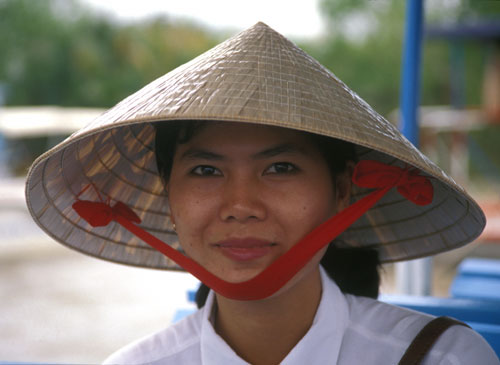Part 5 in a series of travelling among former enemies

Thuy, our guide from My Tho ©1997, James A. Clapp
I have a special affection for rivers. No natural earthly feature is more responsible for the emergence of urban civilization than these riparian givers of life to the land. All the first civilizations, and their cities, sprouted on rivers—the Nile, the Tigris and Euphrates, the Yangtse, the Indus, the Irrawaddy. But perhaps no river has played a role in the turbulent histories of more nations than the Mekong, originating in the mountains of Tibet, and descending through southern China, Burma, Laos, Thailand, Cambodia, and Vietnam before spilling into the South China Sea.
Most Americans probably couldn’t identify the Mekong, which the Vietnamese call the Song Cuu Long (River of the Nine Dragons) before S.E. Asia got on their maps with the Vietnam war, including most of the Americans who were sent to fight and die there. Three decades ago John Kerry and other Swift Boat fighters plied the Mekong and the tributaries of its vast delta in search of Viet Cong who were so mingled with the local village populations that U.S. and South Vietnamese Army forces engaged in “search and destroy” operations from swift boats and helicopter gunships that many innocents were killed, and a large number of delta farmers fled north to Saigon.
The Mekong delta that I visited from My Tho, the provincial capital of about 90 thousand people, shows little after-effects of the war. The town sits on the northernmost tributary of the Mekong, and from here there are islands that may be visited that are lush with the growing of rice (enough to feed all of Vietnam and still make the country the world’s fourth larger exporter of rice), coconut, sugar cane, and many fruits and fish and shrimp. I could not help wonder however whether there were lingering amounts of Agent Orange, the defoliant that was dumped by air on this area to expose the VC. It has returned, thanks to the Mekong, to its verdant lushness, but some American soldiers have claimed negative health effects from the stuff. Still, I saw no kids with antlers or webbed feet.
Thuy, our lovely guide to the nearby island called Tan Long, speaks surprisingly good English, but she is a little rigid, perhaps because the boat company that she works for is owned by the local party cadres. Sue and I are the only two one her boat today and as we head out over the milk chocolate expanse of the river she dutifully fills our heads with statistics and history. But when I ask her questions I am surprised that rather than being an attractive cipher she is quite knowledgeable and confidently and extensively answers to the point where I stop asking questions and offer to answer any she might have about my country. She is hesitant and I prompt her with a compliment about her good English and historical knowledge. Would she like to perhaps attend university in America, I ask. Nine times out of ten in Asia the question elicits a request for a letter of recommendation, a scholarship and room, and board, but Thuy demurs. She really only wants to study about her country, she says, which she can best accomplish at a university here, and it becomes difficult for me to imagine her in a silk pastel ao dai, hair blowing in the breeze as she whirls between Saigon’s night spots on a bright new Honda motorbike. My question leaves a chauvinistic taste in my mouth.
Tan Long, like the other islands, is low and subject to flooding, so it is cut through with canals to assist run-off and lessen flooding. When we take a ride along one of the canals we appreciate the dilemma of the forces in pursuit of the VC. The labyrinth of narrow waterways is lined with high foliage such that one has to all but fall into one to know it is there. The low half-banana boats paddle easily and silently along them with scarcely a width for two to pass. The VC could appear and disappear with suddenness in this environment, and it becomes clearer what pushed the defoliation decision.

Not so swift boat ©1997 James A. Clapp
We make our way past topiary dragons to a modest restaurant for some tea. It is little more than some thin walls and a roof over a tamped dirt floor, and it is difficult to distinguish where the living quarters of the proprietors leave off and the restaurant begins. In a room off the dining room, a father sways in a hammock with his young son; in another, a young woman squats on a table weaving the traditional conical hats. The dining room itself is spotless as possible in a place with a mud-packed floor and walls that do not come down to it. I wonder about snakes. A calendar and a poster of a Vietnamese movie star serve as decorative art. There is something placid and timeless about the place. Only the serene but welcoming mother-proprietor is old enough to remember when black-pajamaed VC and Americans soldiers made a hell of this place. She, and the Mekong.
___________________________________
©2004, James A. Clapp (UrbisMedia Ltd. Pub. 9.9.2004)
